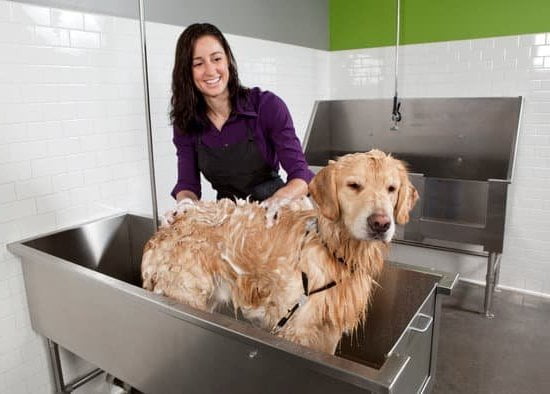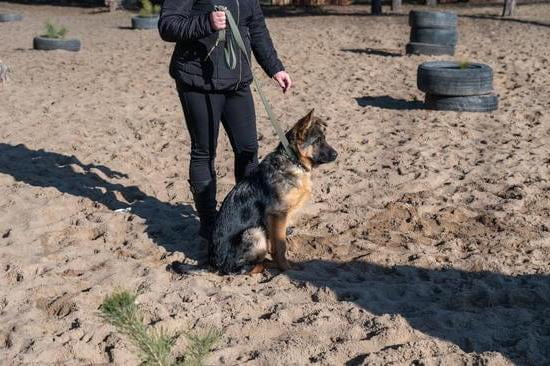Training a dog for an electric fence is a crucial step to ensure their safety and well-being. Many pet owners opt for electric fences as a way to give their dogs the freedom to roam while keeping them within safe boundaries.
However, it’s important to train your dog properly to understand and respect the boundaries of an electric fence. In this article, we will discuss the process of training your dog for an electric fence and focus on understanding the appropriate age at which to begin training.
Determining the right age at which to start training your dog for an electric fence is essential in ensuring that they grasp the concept of boundaries and safety. Starting too early may lead to confusion or fear, while starting too late can make it more difficult for your dog to adapt to the new system. Understanding the developmental stages of dogs will help us determine when they are ready for training.
It’s crucial to recognize the characteristics of a dog that is ready for electric fence training. Observing their behavior, responsiveness, and ability to follow basic commands will play a significant role in preparing them for this type of training. By considering these factors, we can effectively train our furry companions and provide them with the freedom they crave while keeping them safe and secure within their designated area.
Understanding the Age at Which Dogs Can Begin Training
The age at which dogs can begin training for an electric fence is crucial in ensuring the success of the training process. It is important to understand that puppies should not be trained on an electric fence until they are at least 6 months old.
This is because younger puppies may not have developed the necessary cognitive abilities to understand the boundaries set by the electric fence. Additionally, their physical development may not be advanced enough to handle the mild shocks delivered by the fence.
As a general rule, it is best to wait until your dog has reached adulthood before starting electric fence training. For most breeds, this means waiting until they are around 1 year old. By this age, dogs have typically matured both mentally and physically, making them better equipped to understand and respect the boundaries of an electric fence.
It’s also worth noting that some larger breeds may take longer to mature, and it’s important to keep this in mind when considering when to start electric fence training. Consulting with a professional dog trainer or veterinarian can also provide valuable insight into when your specific dog breed may be ready for electric fence training.
| Age | Training Start |
|---|---|
| Under 6 months | Not recommended |
| 6 months – 1 year | Caution advised, consult a professional |
| 1 year and older | Ideal time to begin training |
Characteristics of Dogs Ready for Electric Fence Training
When considering training your dog for an electric fence, it is important to understand the characteristics that make a dog ready for this type of training. Not all dogs are immediately suited for electric fence training, so it’s crucial to assess whether your furry friend is prepared for this kind of training process.
Some key characteristics that indicate a dog is ready for electric fence training include:
- Age and maturity: Dogs should be at least 6 months to a year old before starting electric fence training. Younger dogs may not have the attention span or impulse control needed for this type of training.
- Basic obedience: Dogs should have a solid foundation in basic obedience commands such as sit, stay, come, and leave it. This shows that they are responsive to your commands and have some level of self-control.
- Fearlessness and confidence: Dogs that startle easily or are timid may not be good candidates for electric fence training. They should be confident and able to handle the occasional minor correction from the fence.
Assessing these qualities in your dog will help you determine if they are ready for electric fence training. It’s vital to set your pet up for success by ensuring they possess the necessary characteristics before beginning their training.
Keep in mind that every dog is unique, and some may be ready for electric fence training sooner than others. Be patient and observant, and pay close attention to your dog’s behavior and responses during the training process. By doing so, you’ll ensure a positive experience for both you and your beloved pet.
Steps for Training Your Dog for an Electric Fence
Training your dog for an electric fence is a crucial step in keeping them safe and secure within the boundaries of your property. Proper training ensures that your furry friend understands the limits they must respect without causing them unnecessary stress or harm. Here are some essential steps to follow when training your dog for an electric fence.
Introduction to the Fence System
Before anything else, introduce your dog to the electric fence system. Allow them to become familiar with the collar they will wear and let them see and hear the warning signals when they approach the boundary of the designated area. This step helps your dog associate the warning signal with the physical boundary of their territory.
Positive Reinforcement and Reward-Based Training
During this process, use positive reinforcement techniques such as treats, praise, or playtime to encourage desired behavior when approaching or backing away from the boundary. Your goal is for your dog to have a positive association with staying within their boundaries, and rewards can help accomplish this.
Gradual Boundary Exposure
When it comes time to expose your dog to the actual shock of the electric fence, do so gradually. Set up temporary visual markers and supervise your dog while walking them near these markers. Allow them to receive a mild correction if they attempt to cross over, but be there to reassure and comfort them immediately after.
By following these steps and being patient with your furry companion, you can successfully train them for an electric fence at any age while ensuring their safety and happiness within their designated space.
Common Mistakes to Avoid During Training
Improper Introduction to the Fence
When training your dog for an electric fence, one common mistake to avoid is introducing your pet to the fence too quickly. It is important to let your dog become familiar with the physical boundaries of your property before activating the electric feature. This will prevent your pet from associating fear or discomfort with the entire outdoor area.
Inconsistent Training and Reinforcement
Another mistake to steer clear of is inconsistent training and reinforcement. Dogs thrive on consistency, so it’s crucial that you establish a routine and stick to it throughout the training process. Inconsistency can confuse your pet and lead to failed training attempts.
Using Punishment Instead of Positive Reinforcement
Using punishment like yelling, hitting, or using shock correction as part of the electric fence training can be detrimental. It will lead to fear and stress in your dog, causing negative associations with the training process and potentially leading to behavioral issues. Using positive reinforcement techniques such as treats, praise, and rewards for good behavior is a much more effective approach.
By avoiding these common mistakes during electric fence training, you can ensure a positive and successful experience for both you and your furry friend. Remember that patience, consistency, and positive reinforcement are key elements in creating a safe and happy environment for your pet within the boundaries of your property.
Tips for Reinfocing Training and Providing Positive Reinforcement
After successfully introducing your dog to the concept of an electric fence, reinforcing their training and providing positive reinforcement is essential for long-term success. Positive reinforcement is the most effective method of training for dogs of any age, including those being trained for an electric fence. Here are some tips for reinforcing your dog’s electric fence training and providing positive reinforcement:
1. Use treats and praise: When your dog shows signs of understanding the boundaries of the electric fence, reward them with their favorite treats and plenty of verbal praise. This positive reinforcement will help solidify their understanding of the fence boundaries and encourage good behavior.
2. Practice consistency: Consistency is key when reinforcing training for an electric fence. Be sure to consistently enforce the boundaries and provide positive reinforcement each time your dog respects the boundary lines. Inconsistency can lead to confusion and setbacks in their training progress.
3. Incorporate regular training sessions: Even after initially training your dog for the electric fence, it’s important to continue regular training sessions to reinforce their understanding of the boundaries. Regular practice will help maintain their obedience and ensure that they remain safe within the designated area.
4. Provide mental stimulation: In addition to physical exercise, dogs also need mental stimulation to keep them engaged and well-behaved. Consider incorporating interactive toys, puzzle feeders, or training games into their routine to keep them mentally sharp and focused on respecting the electric fence boundaries.
5. Offer affection and attention: Dogs respond well to affection and attention from their owners. By providing love, attention, and regular bonding time with your dog, you can further reinforce their positive behavior within the confines of the electric fence.
By utilizing these tips for reinforcing training and providing positive reinforcement, you can ensure that your dog continues to respect the boundaries of an electric fence as they gain more freedom in a secure environment without risking harm or danger through escaping or wandering off unsupervised.
Troubleshooting and Problem-Solving During Training
The training process for an electric fence can be a challenging task, and it’s not uncommon for dog owners to encounter issues along the way. Troubleshooting and problem-solving during training is an essential part of ensuring that your dog understands the boundaries set by the electric fence. It’s important to address any issues that may arise promptly to prevent any setbacks in the training process.
One common problem that dog owners may face during training is their dog’s fear or reluctance to approach the boundary of the electric fence. This can be due to a variety of reasons, such as previous negative experiences or a lack of understanding of the concept.
In these cases, it’s crucial to take a step back and reevaluate the training approach. Providing positive reinforcement and reassurance can help alleviate your dog’s fears and build their confidence in understanding the boundaries.
Another issue that may arise during training is your dog’s tendency to test the boundaries of the electric fence. Some dogs may attempt to push the limits by running toward the boundary despite receiving a warning from the collar. This behavior can be challenging to address but consistency and patience are key. It’s important to reinforce the consequences of crossing the boundary while also providing positive reinforcement when your dog stays within the designated area.
In addition to fear and boundary testing, some dogs may exhibit signs of confusion or uncertainty during training. This can manifest in behaviors such as pacing along or near the boundary line or hesitating to enter or leave certain areas. Understanding your dog’s body language and behavior cues is crucial in identifying these issues early on and addressing them effectively.
| Training Issue | Solution |
|---|---|
| Dog’s fear or reluctance to approach electric fence boundary | Provide positive reinforcement, reassurance, and reevaluate training approach. |
| Dog testing boundaries of electric fence | Consistency, patience, reinforce consequences of crossing boundary, provide positive reinforcement for staying within designated area. |
| Dog exhibiting signs of confusion or uncertainty | Understanding body language and behavior cues, early identification, effective addressing. |
Gradual Integration of Electric Fence and Off-Leash Freedom
In conclusion, training your dog for an electric fence is a crucial step in providing them with the freedom to roam while ensuring their safety. Understanding the age at which dogs can begin training is essential, as it allows you to gauge when your furry friend is developmentally ready for this type of instruction.
Characteristics of dogs ready for electric fence training include a strong understanding of basic commands and a willingness to learn, making the process smoother and more effective.
When it comes to training your dog for an electric fence, it’s important to follow the steps outlined in this article carefully. Avoiding common mistakes and reinforcing positive behavior will set the foundation for successful integration of the electric fence system and off-leash freedom. Additionally, troubleshooting any issues that may arise during training will help ensure that your dog understands and respects their boundaries.
Remember, the gradual integration of the electric fence and off-leash freedom is key. Start slow and gradually increase your dog’s exposure to their newfound freedom. With patience and consistent training, your dog will soon understand how to navigate their boundaries while enjoying the benefits of off-leash playtime. By following these guidelines, you can successfully train your beloved pet for an electric fence system at any age.
Frequently Asked Questions
How Old Should a Puppy Be for an Electric Fence?
A puppy should be at least 6 months old before being trained to use an electric fence. By this age, they have developed enough physically and mentally to understand the boundaries set by the fence.
At What Age Can a Dog Use an Invisible Fence?
Typically, most experts recommend that a dog should be at least 6 months old before being trained to use an invisible fence. At this age, they are better able to understand and follow the training process.
Can an Older Dog Learn Electric Fence?
Yes, an older dog can learn to respect an electric fence with proper training and guidance from their owner. It may take more time and patience compared to training a puppy, but it is definitely possible for older dogs to learn and adapt to using an electric fence safely.

Welcome to the blog! I am a professional dog trainer and have been working with dogs for many years. In this blog, I will be discussing various topics related to dog training, including tips, tricks, and advice. I hope you find this information helpful and informative. Thanks for reading!





